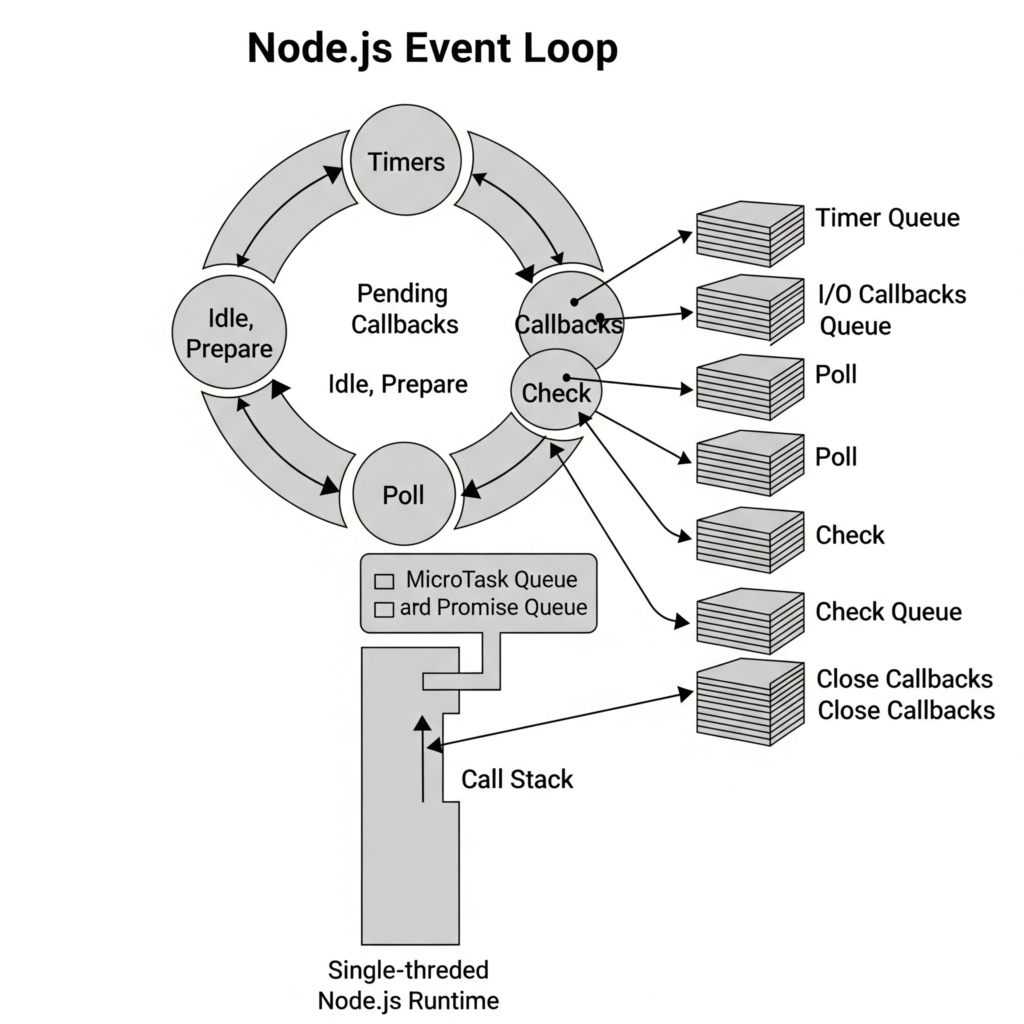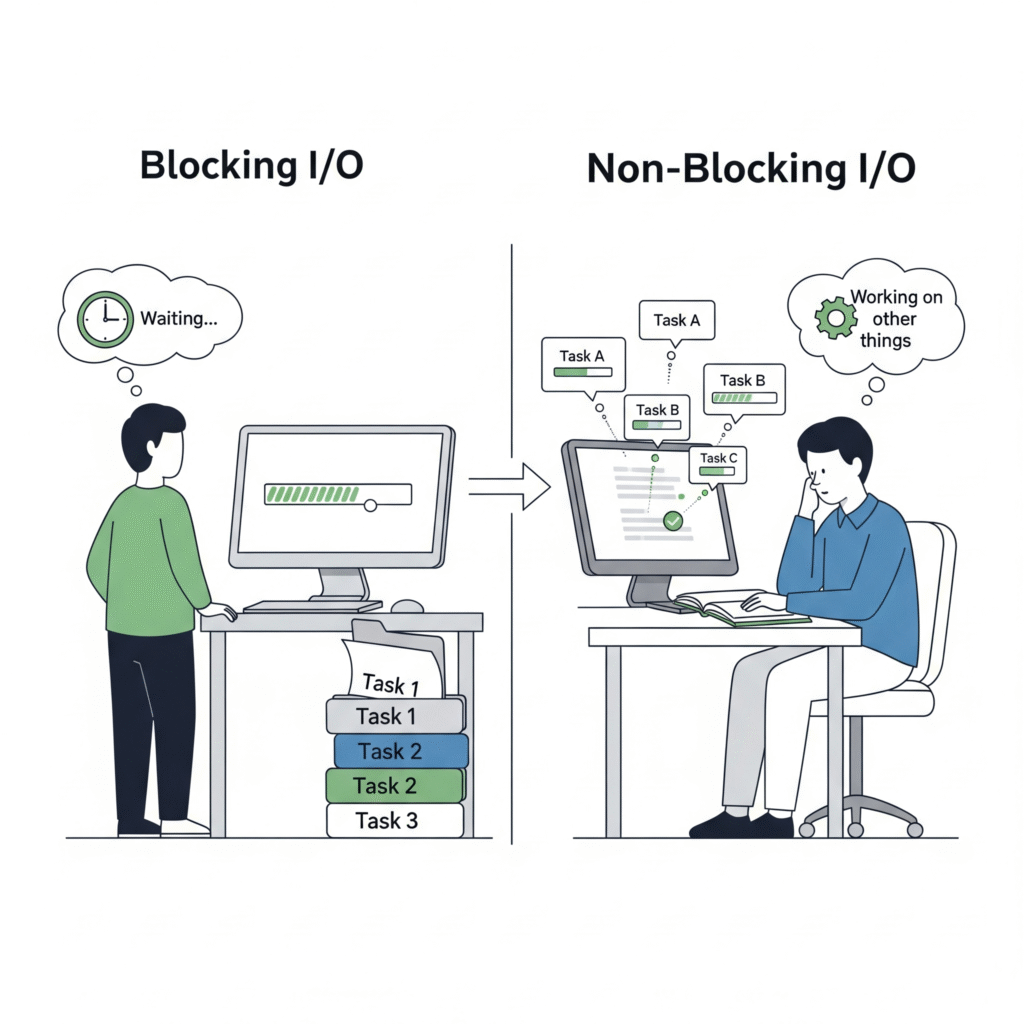Introduction
Node.js has become a cornerstone technology for modern web development, particularly for building fast, scalable, and real-time applications. A solid understanding of its core concepts and ecosystem is vital for any developer. This guide provides a comprehensive list of the top 50 Node.js interview questions you’re likely to face, covering everything from fundamental principles to advanced topics and best practices.



Foundational Node.js Interview Questions
1. What is Node.js?
Node.js is an open-source, cross-platform JavaScript runtime environment built on Chrome’s V8 engine that allows executing JavaScript code outside a browser. It is mainly used for building scalable server-side applications.
2. What are the key features of Node.js?
Key features include its event-driven and asynchronous I/O model, single-threaded but highly scalable nature, non-blocking architecture, fast execution with the V8 engine, and a rich ecosystem with npm (Node Package Manager).
3. What is the Event Loop in Node.js?
The Event Loop is a crucial mechanism that handles asynchronous callbacks. It allows Node.js to perform non-blocking I/O operations by offloading tasks to the system kernel and processing them in a queue once they are complete. This is a fundamental concept often asked in Node.js interview questions.
4. What is a callback in Node.js?
A callback is a function passed as an argument to another function, which is then executed after the main function’s task completes. Callbacks are a common pattern for handling asynchronous operations.
5. What are Promises in Node.js?
Promises represent the eventual completion (or failure) of an asynchronous operation and provide a cleaner, more readable alternative to nested callbacks, helping to avoid “callback hell.”
6. How do you handle errors in Node.js?
Errors can be handled using callbacks (by checking the first error argument), try-catch blocks for synchronous code, and .catch() blocks for Promises. Express.js also has dedicated error-handling middleware.
7. How does Node.js handle concurrency?
Node.js uses an event-driven, non-blocking I/O model with a single-threaded event loop, allowing it to handle many concurrent operations efficiently without the overhead of multiple threads.
Node.js Core Modules & Concepts
8. What is the difference between require() and import?
require()is the traditional Node.js CommonJS module syntax.importis the newer ES6 module syntax, which is supported in Node.js starting from version 12+ when"type": "module"is set inpackage.json.
9. What is the package.json file?
package.json is a manifest file that contains metadata about a Node.js project, including its dependencies, scripts, version, and other configurations.
10. How do you manage dependencies in Node.js?
Dependencies are managed using npm (Node Package Manager) or yarn. You add packages via the command line (npm install <package>) and their versions are specified in package.json.
11. What is the significance of the package-lock.json file?
package-lock.json locks the exact versions of dependencies installed, including all nested dependencies, ensuring consistent and reproducible builds across different environments. This is a key detail to mention in Node.js interview questions.
12. What is the role of npm in Node.js?
npm is the default package manager for Node.js, used to install, manage, and share reusable code packages (modules).
13. What is the difference between process.env and dotenv?
process.env accesses environment variables available to the Node.js process. dotenv is a popular package used to load environment variables from a .env file into process.env.
14. Explain the concept of streams in Node.js.
Streams are objects that allow reading or writing data continuously in small chunks, enabling efficient data processing for large files or network communications without buffering the entire data in memory.
15. What are the different types of streams in Node.js?
The main types are Readable streams (to read data), Writable streams (to write data), Duplex streams (both read and write), and Transform streams (to modify data as it is read or written).
16. What is the purpose of the cluster module?
The cluster module allows Node.js to create multiple child processes (workers) that share the same server port, enabling better CPU utilization and improved performance in multi-core systems.
Asynchronous Programming & Concurrency
17. What is the difference between process.nextTick() and setImmediate()?
process.nextTick()queues a callback to be invoked before the next event loop iteration.setImmediate()queues a callback to be executed after the current poll phase of the event loop.
18. What is the difference between process.nextTick() and setTimeout()?
process.nextTick() schedules a callback to be invoked immediately after the current operation finishes but before the event loop continues. setTimeout() schedules a callback to run after a specified delay, allowing the event loop to continue.
19. What is the difference between blocking and non-blocking I/O?
- Blocking I/O waits for the operation to complete before the program can continue.
- Non-blocking I/O allows other operations to continue while waiting for the I/O operation to finish, leveraging the event loop.
20. How do you handle asynchronous code in Node.js?
Asynchronous code can be handled with callbacks, Promises, the async/await syntax, or libraries like async.js. The async/await syntax is now the preferred method for its readability.
21. What is a callback hell? How do you avoid it?
Callback hell occurs when multiple nested callbacks make code hard to read and maintain. It can be avoided by using Promises, the async/await syntax, or modularizing code into smaller, reusable functions.
Express.js Framework & Web Development
22. What is middleware in Express.js?
Middleware functions in Express.js are functions that have access to the request and response objects, and the next() middleware function. They are used for tasks like logging, authentication, and parsing request bodies.
23. How do you handle file uploads in Node.js?
File uploads are commonly handled using middleware like multer, which parses multipart/form-data and makes files available for processing.
24. What is CORS and how do you enable it in a Node.js app?
CORS (Cross-Origin Resource Sharing) is a security feature that restricts web pages from making requests to different domains. It can be enabled in Express.js applications using the cors middleware package.
25. What is the difference between app.use() and app.get() in Express?
app.use()mounts middleware functions for all HTTP methods and routes.app.get()handles HTTP GET requests for a specific route.
26. How do you create a simple HTTP server in Node.js?
You use the built-in http module. A common example is:
JavaScriptconst http = require('http');
const server = http.createServer((req, res) => {
res.writeHead(200, {'Content-Type': 'text/plain'});
res.end('Hello World\n');
});
server.listen(3000);
27. What is the difference between PUT and PATCH HTTP methods?
- PUT replaces the entire resource with a new payload.
- PATCH updates only a part of the resource.
28. How do you implement authentication in Node.js applications?
Common methods include using JWT (JSON Web Tokens), sessions with cookies, OAuth, and middleware libraries like Passport.js.
Security, Debugging & Advanced Topics
29. How do you secure a Node.js application?
Best practices include using HTTPS, validating and sanitizing all inputs, implementing robust authentication, using environment variables for secrets, keeping dependencies updated, and preventing common attacks like XSS and CSRF.
30. How do you debug a Node.js application?
You can use the built-in node inspect command, the debugger in Visual Studio Code, or the Chrome DevTools. Simple console.log() statements are also useful for quick debugging.
31. What is the difference between spawn() and fork() in the child_process module?
spawn()launches a new process with a given command, useful for streaming I/O.fork()is a special case ofspawn()that creates new Node.js processes which can communicate via IPC (Inter-Process Communication).
32. What is the difference between readFile() and createReadStream()?
readFile()reads the entire file into memory at once.createReadStream()reads the file in chunks, making it more memory-efficient for large files.
33. What is the role of the EventEmitter class in Node.js?
EventEmitter is a core class used to handle and emit events. It allows objects to listen for named events and execute callbacks when those events occur, supporting an event-driven architecture.
34. How does the cluster module improve scalability in Node.js?
By creating multiple worker processes that run on different CPU cores, the cluster module enables the application to handle more simultaneous connections and fully utilize the available hardware.
35. What is the difference between synchronous and asynchronous functions in Node.js?
- Synchronous functions block the execution until they finish.
- Asynchronous functions allow the program to continue running while waiting for operations to complete, and then execute a callback when the operation is done.
36. How do you handle environment-specific configurations in Node.js?
By using environment variables, .env files with the dotenv package, or configuration management tools to separate configurations for development, testing, and production environments.
37. What are some common use cases of Node.js?
Common use cases include real-time chat applications, APIs and backend services, streaming applications, single-page applications, and microservices architecture.
38. What is event-driven programming?
It’s a programming paradigm where the flow is determined by events, such as user actions, sensor outputs, or messages from other programs.
39. How do you handle uncaught exceptions in Node.js?
Using the process.on('uncaughtException', callback) event handler can catch errors that are not handled elsewhere, though it’s best practice to handle errors properly to prevent application crashes.
40. How does Node.js handle file system operations?
Node.js uses the fs module for file system operations, offering both synchronous and asynchronous methods to read, write, update, or delete files.
41. What is a Duplex stream? A Duplex stream is a type of stream that is both Readable and Writable, allowing data to be both read from and written to it.
42. What is middleware chaining in Express.js?
Middleware chaining is the process where multiple middleware functions execute sequentially. Each middleware can modify the request/response objects or pass control to the next middleware by calling next().
43. What is the role of the process object in Node.js?
The process object is a global object that provides information about and control over the current Node.js process, including environment variables, arguments, and exit codes.
44. What is the V8 engine?
V8 is the open-source JavaScript engine developed by Google that powers Chrome and Node.js. It compiles JavaScript code directly into machine code for fast execution.
45. What is the difference between app.use() and app.all() in Express?
app.use() applies middleware to all routes and HTTP methods. app.all() applies middleware to all HTTP methods for a specific route path.
46. How do you prevent CSRF attacks in a Node.js application?
By using a CSRF token. The server generates a token, embeds it in a hidden form field, and validates the token on subsequent requests.
47. What is the difference between async and defer attributes in script tags?
The async attribute loads the script asynchronously and executes it as soon as it’s ready. The defer attribute also loads asynchronously but delays execution until after the HTML document has been fully parsed.
48. How do you create and use a custom module in Node.js?
You create a file with your code and use module.exports to expose functions or objects. To use it, you require() the file path.
49. What is the role of _dirname and _filename in Node.js?
_dirname provides the directory name of the current module. _filename provides the file name of the current module.
50. How do you handle POST requests in Express.js?
You use app.post() with a route path and a handler function. You would also use middleware like express.json() or express.urlencoded() to parse the request body.
Summary
Successfully answering Node.js interview questions requires a deep understanding of its asynchronous nature, the Event Loop, and its rich ecosystem of tools and frameworks like npm and Express.js. By mastering these concepts, you can demonstrate your ability to build and maintain high-performance, scalable applications.
This article is part of our Interview Prep series.
For further reading and in-depth understanding, the official Node.js documentation is an excellent resource.



